IFAF European Championship Qualifier: What will Italy’s Blue team be presented with by the Serbian offense?
Aarnout Ecker | 2016 IFAF Europe Qualifying Tourament | 09/04/2016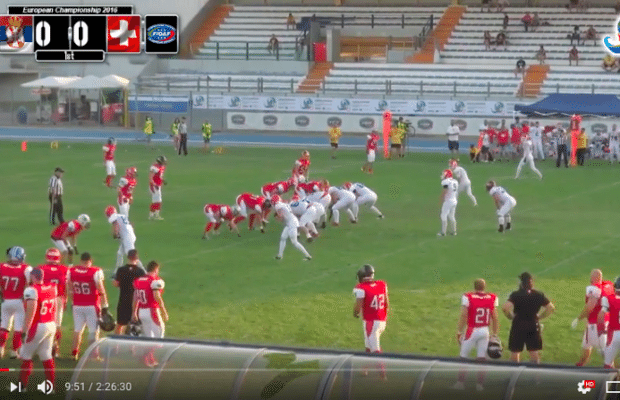
American Football International contributor Aarnout Ecker, a Belgian coaching in Italy for the 2016 Italian champion Milano Rhinos, takes an excellent in-depth look at Sunday’s IFAF Europe Qualifier between Team Italy and Team Serbia. Ecker examines the problems Italy’s defense will face against Serbia’s offense.
Team Italy defeated Israel’s national team in the first game of the IFAF European Championship Qualifier Tournament in Lignano Sabbiadoro, Italy.
While both Italy’s offense and defense got off to a slow start, ending the first half tied with Israel, the defense stepped up big in the second half and shut out the Israelis. (you can watch the entire game here).
The second game of the day saw Serbia win convincingly against Switzerland, 17–0 (watch it here).
As a result Italy and Serbia will be matched up against each other this Sunday to decide who will continue their journey to qualify for the IFAF European Championship.
To get you ready for the game, I’ll give a quick overview of what the Blue team defense can expect from the Serbian offense based on their game against Switzerland.
General overview
Against Switzerland, the Serbians clearly favored the passing game:
- on all downs: 65% passing;
- 1st down: 35% passing;
- 2nd down: 67% passing;
- 3rd and 4th down: 100% passing.
Personnel and formations
Serbia primarily operates from 10 personnel (1 running back, and 4 receivers), but will occasionally utilise 20 personnel (2 running backs and 3 receivers).
With these personnel groupings they line up in the following formations:
Gun Blue/Red Doubles
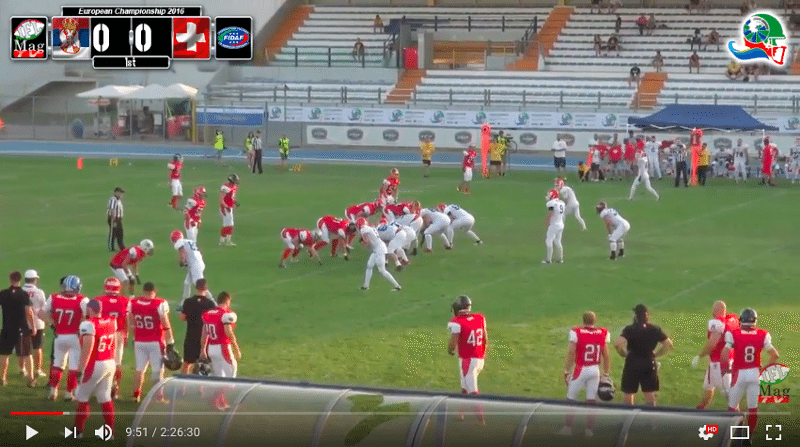
Gun Blue/Red Trips Lt/Rt
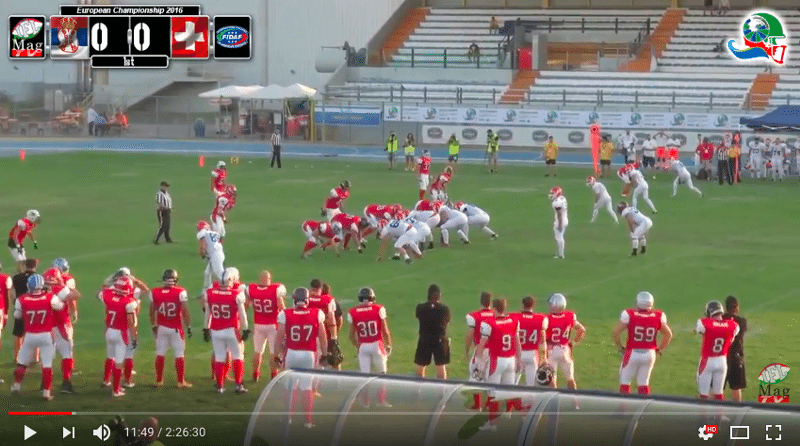 Gun Blue/Red King Twins Lt/Rt
Gun Blue/Red King Twins Lt/Rt
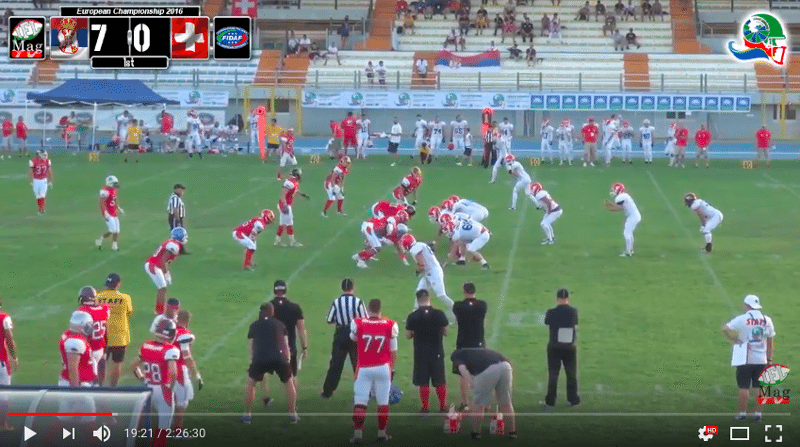
Play selection — RPO
The first play we’ll discuss is a pre-snap RPO, or “Run Pass Option”. The running play in this RPO is the inside zone run by the running back, while the passing play is a bubble route by the #3 receiver in a Trips formation or the #2 receiver in a Doubles formation.
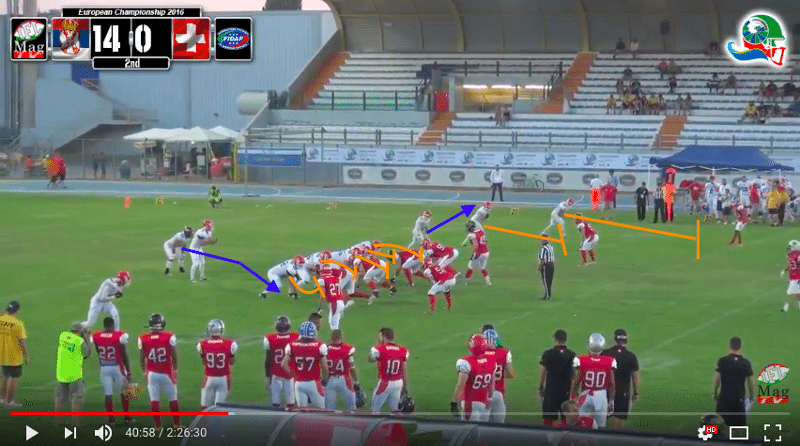
IZ Bubble pre-snap RPO
As you can see in the above screenshot, the Serbian QB is clearly checking whether or not he has a 3 on 2 advantage on the Trips side to decide whether to hand off the ball to the running back or throw the bubble.
RPO IZ Bubble rush
RPO IZ Bubble pass
Finally, after hitting the bubble a couple of times on this play, they will try to catch the defense off guard by faking the IZ bubble and throwing it to the #1 or #2 receiver.
RPO IZ fake Bubble Seam
As you can see from the above clip, if the receiver were to have caught the ball he would have gained an easy first down.
Play selection — Power
The Serbians run the Power play in 3 different ways: (1) from 20 personnel with the FB kicking out the DE and the Guard leading up the alley, (2)from 20 personnel to the opposite side of the FB with the Guard kicking out the DE and the FB leading up the alley and (3) from 10 personnel with the FB kicking out the DE, the RB leading up the alley and the QB keeping the ball.
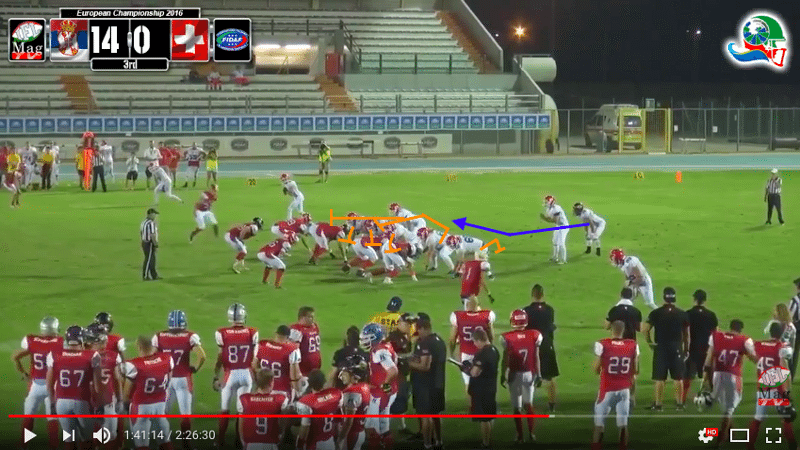
Power with FB kicking out and Guard leading up the alley
First up, the basic Power play with the FB kicking out the DE:
Power
Next up, QB Power. This play is a great addition for an offense that already runs the regular Power play because it involves little new teaching, but it presents the defense with a new look:
QB Power
Play selection — Speed Option
The final running play I’ll go over is the Speed Option.
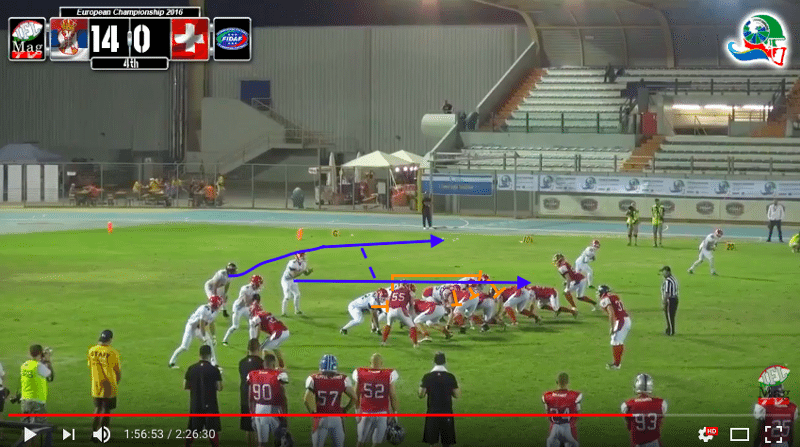
Speed option
This play is blocked by Serbia with a pulling backside guard which makes it look like they would be running QB Power, but instead the RB gets in pitch relationship with the QB, thus stressing the force defender who can’t attack the QB but has to play the pitch (“force” is a term for the defender who has to play every running play outside-in).
Speed Option
Play selection — Smash Concept
In long yardage situations, like the 3rd&11 in the clip below, Serbia likes to run the Smash concept. In this concept the outside receiver runs a hitch route and the slot receiver runs a corner route.
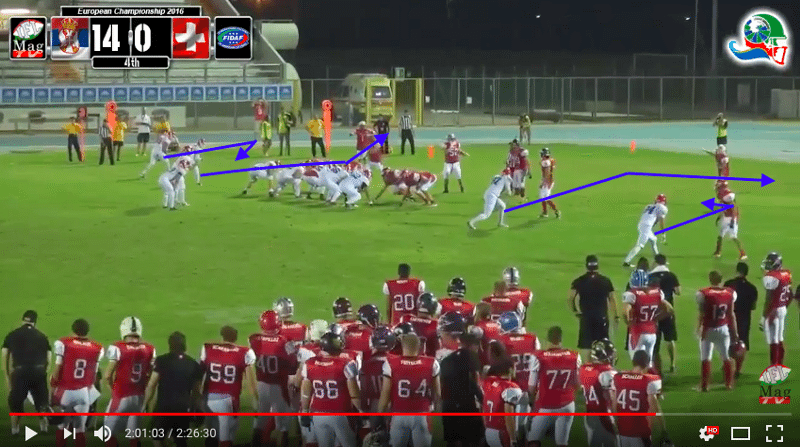
Smash concept
Versus a Cover 2 zone defense the offense will hope to outflank the safety who will have to cover the corner route 1on1 while he’s starting from an inside position on the slot receiver. Ideally on this play, the corner would recognize the concept and sink underneath the corner route as soon as he sees that the QB will not throw to the hitch route underneath.
Versus a Cover 3 zone defense the QB should have an easy 5 yard completion if he throws the hitch route because the cornerback has to play the corner route by the slot receiver over the top.
Smash concept
Play selection — Hitches
If Serbia needs a first down on a critical short yardage situation, say for example 4th&5 or 3rd&5, they expect their receivers to get the job done by running hitch routes. Most likely the QB will read pre-snap which of his receivers outflank their defender and throw the ball quickly based on that read.
Hitches
Play selection — 4 Verticals
In long yardage situations, Serbia likes to run the 4 verticals concept. While this play might look simple or even a desperation play, if coached correctly (see for example Air Raid teams in college football like the Washington State Cougars and Texas Tech Red Raiders), this can be a lethal play in any situation.
4 Verticals
As you can see in the diagram above all 4 receivers run a vertical route, but one of the two inside receivers is given the option to turn his go route into a post if he recognises the defense playing some type of Cover 2 or Cover 4 defense where the middle of the field should be open.
4 Verticals
In the clip above the QB doesn’t find the open receiver, but as the entire defensive backfield has their back turned to the QB and the linebackers are back-pedalling, the QB is left with a lot of room to scramble.
Play selection —Passes to RB in open space
The final play I would like to discuss is not so much a “play” but rather the concept of throwing the ball to the running back from the backfield. As Serbia’s run blocking has not been very effective so far, they find other ways to get the ball into the hands of their running back.
A first way to do that is to run the swing route with the running back while the receivers run deep routes to give the running back space to make a play:
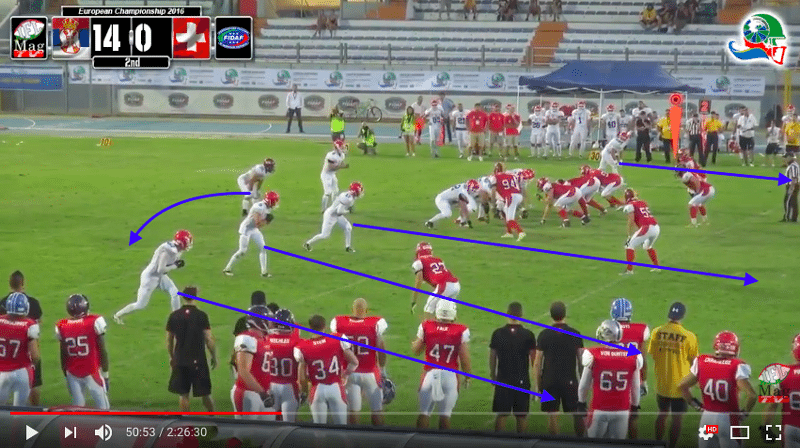
RB swing route
As you will see in this clip, this route allows the offense to put a running back 1-on-1 with a smaller defensive back or with a linebacker who has to sprint all the way to the outside and who should be less agile than a running back in open space.
Swing pass
Finally, we have the RB middle screen where the offensive line lets the defensive line rush upfield and then sets up a wall for the running back to run behind.
RB Middle Screen
As you will have noticed from the description above, the Serbian offense is not very multiple or surprising in the way it operates. Nevertheless, the Blue team defense will have to remain focused all game long and the defense shouldn’t forget that Serbia managed to defeat them just a year ago.
A lot will be on the line tomorrow, but if the leaders on Italy’s defense keep their cool all game long and get everyone to play as one, they will allow their team to win this qualifying tournament.
Original blog post by Aarnout Ecker.
HEADLINES
-
Advertisement
-
Advertisement